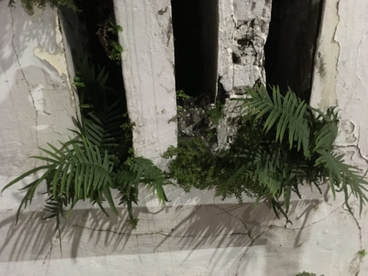 Pteris vittata growing on the walls of a church at E. Palm and N. Florida, Tampa, FL. Pteris vittata growing on the walls of a church at E. Palm and N. Florida, Tampa, FL. I got into Tampa recently to attend a conference and took a cab to my accommodations. As we rounded the corner approaching the house, I saw something really exciting out of the corner of my eye – plants, growing out of the brickwork in the wall of an old church. And not just any plant, but yes, it was – Pteris vittata, the very fern I work with! The star of the arsenic remediation show, native to the eastern half of China, now widely distributed in tropical and subtropical regions worldwide. And growing in walls, stonework, toxic waste sites, and other inhospitable habitats in Florida. The fern’s ability to thrive outside of its native habitat, without human help to reproduce, has earned it a Category II listing on Florida Exotic Pest Plant Council's 2017 List of Florida's Most Invasive Species. Category II, take note, means P. vittata can potentially disrupt native plant communities but is not currently doing so. And since it is not currently doing so, we might call it a naturalized plant (reproducing without human help, but not becoming a member of the local plant community), instead of invasive. As soon as it is found disrupting native plant communities, it moves up to a Category I invasive plant. It’s worth considering whether P. vittata is invasive or simply naturalized. Perhaps P. vittata developed it’s arsenic hyperaccumulation ability so it could outcompete other plants in these marginal habitats, potentially implying that it was not very competitive in less marginal, more hospitable areas. Indeed, we exploit this competitiveness in high-arsenic soils – certainly marginal habitat – when we use the fern for arsenic phytoextraction. We want the plant to thrive in our remediation project, but not reproduce successfully in the surrounding ecosystem. While there aren’t a lot of phytoremediation field studies investigating how the fern behaves (and reproduces) outside of controlled greenhouse conditions, a field study in Florida didn’t find any young P. vittata ferns reproducing outside of the study area—a good thing. In my field studies, in a Mediterranean climate far different than humid Florida, I don’t find any ferns reproducing either. And it’s not for lack of spores – the fern produces so many spores we have to wear dust masks when working around them. The spores seem to require very specific humid, warm conditions to germinate, which we don’t have here in the Bay Area outside of greenhouses. What happens when we use truly invasive plants for phytoremediation? Well, they invade local plant communities – something we don’t want to happen. For example, following some careful research with Oregon scientists, a phytomining company set up a venture using the nickel hyperaccumulator Alyssum murale to pull nickel out of serpentine soils in the Kalmiopsis region of southern Oregon. The Kalmiopsis is famous for its endemic plant communities suited to the tough serpentine environment, and in fact many hyperacumulators have evolved on serpentine soils, naturally high in metals. However, Alyssum murale was not native to the Kalmiopsis. Even though the company was initially very responsible when collaborating with the scientists, they were less conscientious about harvesting the Brassica before it went to seed once they were working on their own. The highly invasive plant spread like a lightning fire at the end of a long dry western summer, and the phytomining company pulled out and ran, leaving a botanical mess. Now, helicopters buzz the area looking for stands of the brushy yellow flowering plant – although locals worry the copters are searching for another nonnative flowering plant commonly found in northern California!
0 Comments
|
AuthorSarick Matzen completed his PhD in Environmental Science, Policy, and Management department at University of California, Berkeley in 2020. He is now a postdoc in the Soil, Water, and Climate Department at the University of Minnesota working on iron cycling in marine systems. Archives
July 2019
Categories |


 RSS Feed
RSS Feed
